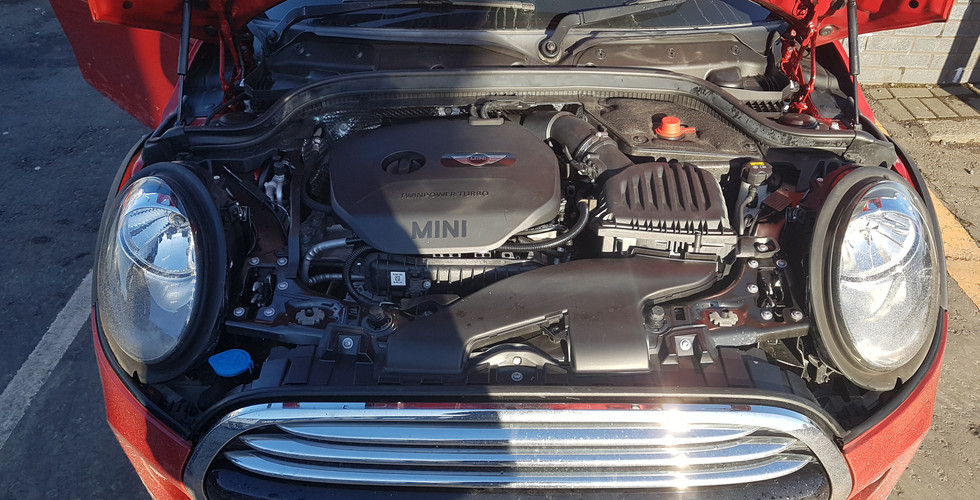Nah. I still wouldn't have one.
- FinalDrive Magazine

- Feb 9, 2018
- 4 min read
2015 MINI Cooper Three-Door Hatchback Review:
The modern MINI. I find it difficult to approach this one professionally; I’ve been an outspoken nay-sayer of BMW’s attempt at my favourite motoring icon ever since the brand was relaunched by the Germans in 2001. However, we shall persevere. And I’ll try not to rant.
Let’s start with the styling. I’ve never liked the way the BMW MINI looks, and the latest incarnation is no exception. It’s even bigger than the 2013 model, adopting a flabbier, more portly appearance as it sinks into its middle age. The grille sticks out like an alcoholic’s beer-gut and the rear has all the shape and tone of a hippo’s arse-crack, producing a “MINI” with dimensions far beyond the semantic realm of the adjective scrawled across is smarmy little badge.
But I digress. It’s about 4 inches longer than its predecessor and provides no extra interior space for its new-found bulk. The rear seats are pretty much useless if the driver’s over 5 feet tall. Which I am. Also, the front seats are overly bolstered, which a) makes the cabin feel even smaller and b) locks your shoulders in place so tightly that you can’t articulate them through tight junctions. I got stuck in the seat on my way out of the dealership and had to pry myself out with the wheel.
Speaking of which, I don’t like the steering wheel either. Lately, every manufacturer has this habit of putting “sporty handholds” at 10 o’clock and 2 o’clock in every vehicle they sell, regardless of its market. Even the Toyota ProAce van has them, for Christ’s sake. The MINI Cooper takes it too far though; the lumps are so thick that you can’t hold the wheel properly. The wheel feels like it’s got a birth defect or a particularly unpleasant cyst. It’s weird.
The dash is funky enough, what with its fancy touch-screen sat-nav thingy and its retro-style buttons and gauges. But it’s too big. The proportions are odd. Look at the distance between the steering wheel and the windscreen. There’s a good foot-and-a-half of dashboard separating them, which I find a bit unnecessary as the engine doesn’t protrude into the cabin. The space saved by fitting a shallower dash could have been given to the rear passengers.
But, and this is difficult for me to say, it drives quite well. It feels very planted, thanks mostly to the optional wider alloys, and isn’t plagued by the woeful understeer which haunts most of its Japanese rivals. The suspension is bouncy and pliant, coping with both corners and potholes with ease. It’s a capable machine; I tackled sharp hairpins at 30–40 mph and the front refused to wash wide. It wouldn’t keep up with a Fiat 500 Abarth on a back road by any stretch of the imagination, but it isn’t bad.
The pedals are odd, with all three being very heavy and very unresponsive. It’s a strange combination. The brakes are weighty, but only have about an inch of travel, so I struggled to stop it smoothly. The clutch tells a similar tale; it’s heavy and it engages the second your foot rises off the firewall, which meant the car was bucking like an irritated stallion for the first couple of miles until I got used to it. And the throttle (in sport mode at least) is a bit sensitive and feels like it’s programmed to emulate cable-operated setup, which it does rather poorly.
But at least the engine’s half-way decent. Mine was fitted with a 1.5 litre, 4-cylinder, turbocharged petrol, producing 134 bhp and 162 ft/lbs of torque. Supposedly it’ll do 0–60 mph in 7.6 seconds, but I’m not sold. The turbo’s tiny and comes on-boost very quickly, likely to lull the punters into believing its quick on test-drives. But don’t be fooled; once the engine crests 5,000 rpm, the boost drops off and you’re left with a disappointing crawl to the 7,000 rpm redline instead of the buzzy, exciting chase you expected.
I can see what BMW have tried to do. They’ve tried to revive the driving experience of the original Mini by artificially weighting the controls and fitting clever turbos. Everything’s heavy, the car feels different to other modern hatchbacks, but no amount of crafty engineering can distract me from the fact that this (rather large) metal box lacks everything that made its grandmother great.
It lacks joy. It lacks passion. It has no soul. To drive, it feels completely isolated from the world; there’s no wind noise, there’s little engine noise, there’s no feedback from the controls. The engine doesn’t revel in the opportunity to show me how high it can rev, the turbo doesn’t cat-call every woman it passes, and the exhaust doesn’t crackle and bang like a box of fireworks thrown onto a campfire. I couldn’t feel the surface of the road in my fingertips; the car didn’t urge me to drive it quickly. And I’ll bet it doesn’t know a single joke.
The MINI Cooper is no more than a stylised appliance, like an iPhone or one of those fancy Nespresso coffee machines. BMW came close to producing a half-way decent tribute act, but dropped the ball at the last hurdle. If only they could have abandoned their German sensibility for once, hired a few of the jobless lads from Longbridge and had the occasional strike or two, this might have been a better car.
But they didn’t. So, it isn’t. And I still hate the way it looks.
Luke Wilkinson 2018 ©


















Comments